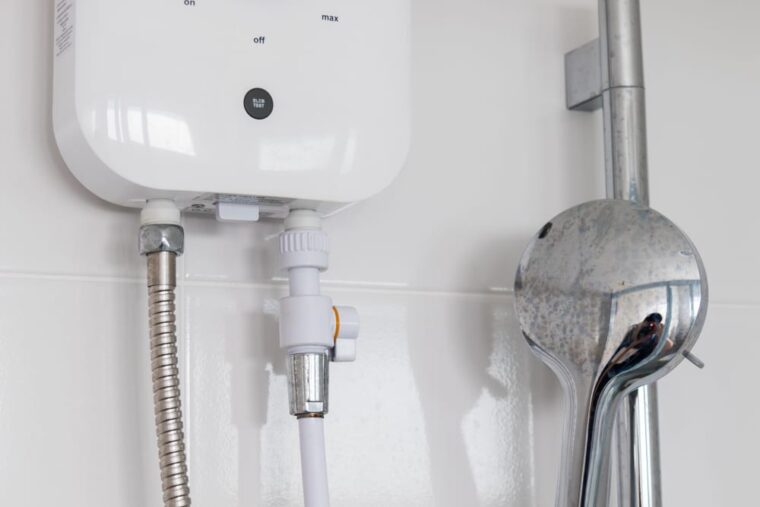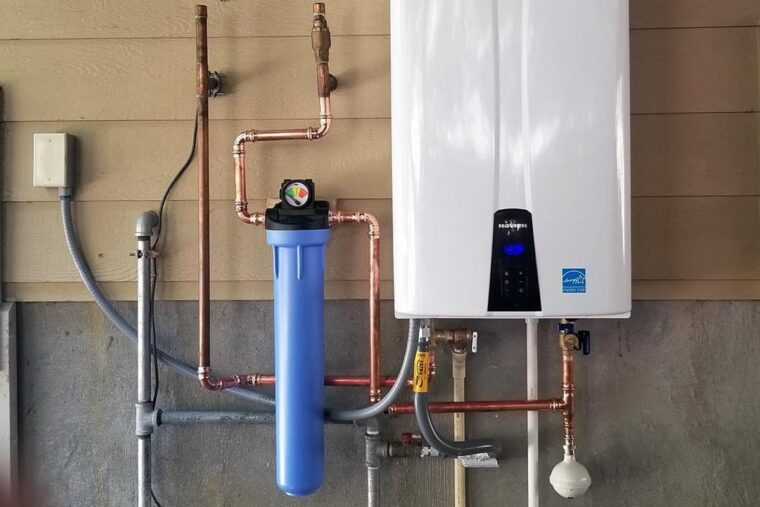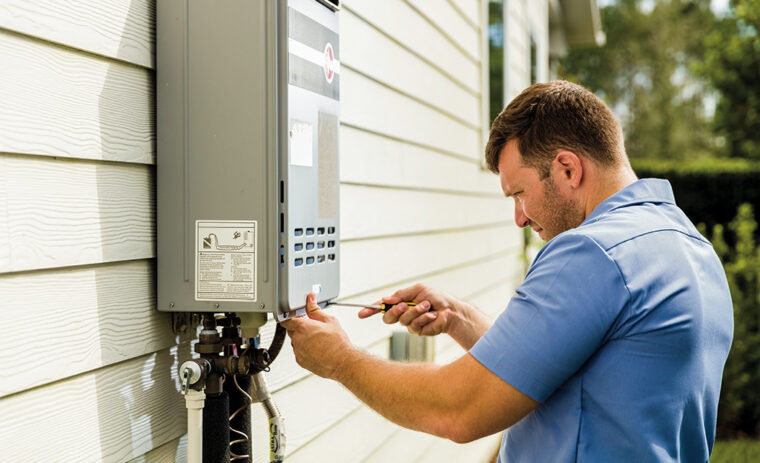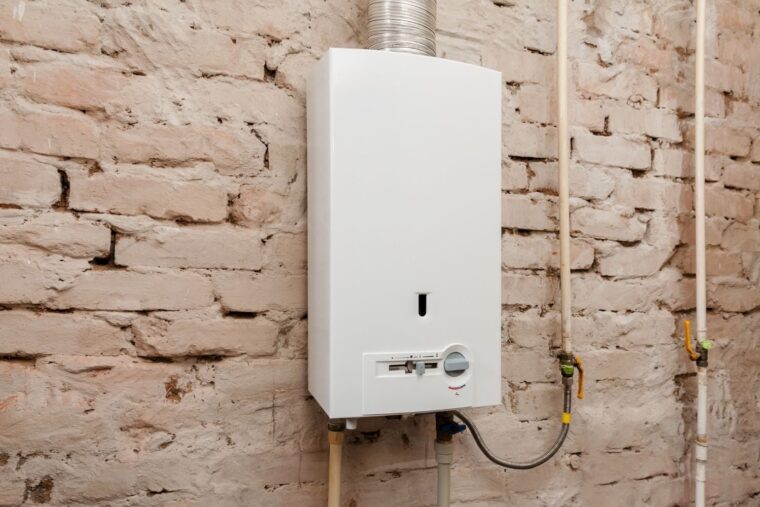If you’re looking for ways to save money in 2024, here’s an idea: switch to a tankless water heater! Not only will a tankless water heater save you money on your utility bills, it can also give you more control over your hot-water usage and allow for faster hot-water delivery.
In this blog post, we’ll explore the ways a tankless water heater can help you get the most bang for your buck in 2024.
Benefits of a Tankless Water Heater
Tankless water heaters provide numerous benefits over traditional tank-style units. They take up less space and can be installed in various locations around your home, eliminating the need for large storage tanks. They are also much more efficient, delivering hot water on demand without having to keep a reserve of heated water constantly maintained. This means that you’ll save money on energy costs compared to a conventional storage-tank system.

Other advantages include:
- Less stand-by energy loss: They don’t require energy to keep a tank of stored hot water heated. This results in lower standby losses than those experienced with conventional tank systems.
- Longer lifespan: Since they use less energy and put less strain on their components, tankless models can last up to twice as long as their traditional counterparts – increasing the life of your appliance significantly.
- Lower maintenance requirements: Because they don’t have a big storage tank, they require fewer repairs over time than conventional systems and don’t need frequent tune-ups or drain cleaning/repair jobs like standard tanks do.
Cost Comparison: Tankless vs. Traditional Water Heaters

When it comes to understanding the costs of different water heater models, one of the biggest factors to consider is the size of the unit. Traditional or tank water heaters typically come in a variety of sizes, ranging from 20 gallons to 80 gallons or larger. The smaller units are more energy-efficient and less expensive upfront but can require more frequent maintenance and heating cycles, leading to higher long-term costs. On the other hand, tankless or on-demand water heaters are much smaller and can usually be installed at any location with a nearby water source.
In addition to purchasing and installation costs, there are operational expenses related to both tank and tankless water heaters. Tank water heaters require natural gas or electricity in order to keep a constantly replenished supply of hot water ready for use; these energy costs add up over time and have been known to increase utility bills significantly each month. By contrast, tankless (or on-demand) systems only provide hot water when necessary and don’t use as much energy overall, resulting in potentially lower monthly expenses for homeowners who choose this option over traditional models.
When comparing all of these factors—the initial cost, installation complexity, operational costs—it’s easy to see why so many people opt for tankless solutions over traditional equipment:
- Shorter recovery times;
- Lower ongoing operational expenses;
- Small space requirements;
- Quiet operation;
- Endless hot water supply;
- Greener options with low emissions rate;
- No risk of flooding due to an overflowing storage tank.
All of these factors make switching from an old storage model a truly lucrative endeavor that has a large ROI potential.
Installation and Maintenance of a Tankless Water Heater

It is important to take into consideration the initial cost of installation and maintenance when deciding whether or not to purchase a tankless water heater. Installation of this type of water heater can involve complex electrical or gas connections, especially in retrofit applications. Additionally, it may be necessary to hire a specialist plumber or electrician to ensure proper installation. For new construction, many local plumbing codes may require the use of tankless water heaters since they are far more efficient compared with traditional storage tank-type heaters.
If you need to replace an existing tank-type water heater with a tankless model, it is also important to consider how long the existing system has been in use and if there are any components that can be reused instead of replaced with new parts. If many components need replacement alongside the water heater itself, opting for professional installation can help minimize labour costs and ensure proper sizing for optimal efficiency.
Regular maintenance is key when using this system as many basic repairs are fairly easy and inexpensive; however, specialized repairs should only be done by qualified professionals to reduce the risk of damage or injury occurring during repair operations. Regular flushing also helps ensure that sediment accumulation in your pipes does not decrease your hot water volume over time or coat internal components which could lead to corrosion inside the system over time. It is recommended that you flush your system annually or bi-annually depending on usage levels within your household / building in order avoid sediment build up affecting performance and efficiency levels over time.
Tips for Maximizing Savings with a Tankless Water Heater

They are becoming more popular thanks to their energy efficiency, cost savings, and space saving capabilities. While they can require a slightly larger initial investment compared to traditional tank-style water heaters, the long-term financial benefits make them an attractive option. Here are a few tips on how you can maximize your savings when installing and using a tankless water heater in your home.
- Choose the Right System – Choose the right system for your home by researching what size and type best meets your needs. Smaller households may be able to get away with one large installed unit while larger households or those with higher hot water needs should opt for multiple smaller units to ensure adequate hot water supply.
- Routine Maintenance – Make sure you are scheduling regular maintenance on your tankless system to help keep it running at peak efficiency. Check all connections, hoses and seals for signs of wear or aging annually and replace any necessary parts if need be. Regular cleaning of the intake screens on the unit is also important as this will insulate it against calcium build up which can reduce its effectiveness over time.
- Use Hot Water Strategically – Only use hot water when necessary and turn down the temperature setting on your tankless system when not in use so that you’re not wasting resources heating up more than you need. Reducing incoming water temperatures by even a few degrees can result in significant Celsius savings over time; depending upon usage habits install thermostatic mixed valves that continually mix hot and cold waters automatically as needed!
Conclusion

In conclusion, the primary benefit of tankless water heaters is their energy efficiency. They provide hot water when it’s needed and don’t waste energy heating and storing it unnecessarily. This can result in considerable cost savings both through lower energy bills and rebates and incentives.
